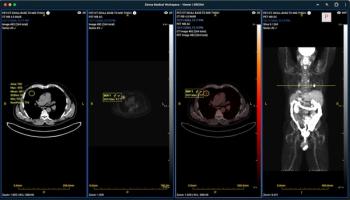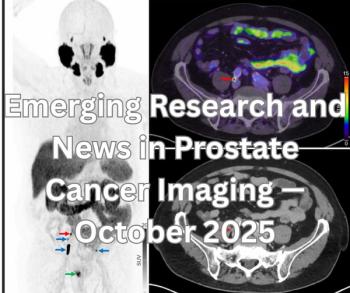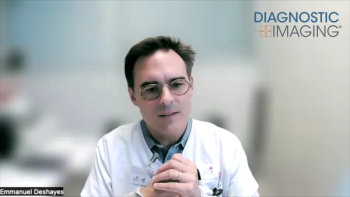
Comparing Agents in Prostate Screening
Imaging experts compare gallium-based agents to non–gallium-based agents for prostate cancer screening.
Episodes in this series

Umesh Oza, MD: We’re getting into physics a little bit. But those are the 2 differences there. While we’re on the physics topic, [regarding half-life]. We know F-18–based ones are about 110 minutes, right? Generally, gallium-68 is similar to the 68. It’s about 68 hours; easy to remember that way. That plays into how we can use it. Generally, an hour half-life is a pretty good tracer. We’re not talking [about] our cyclotron-produced 10-minute, 2-minute, 5-minute tracers, which totally decay fast. You just need to be right next to a cyclotron. Good...clinical application of both, in that sense. Do you see any differences? Have you noticed, or have you seen anywhere in the literature any differences, generally speaking, about their sensitivity or specificity, or in certain, let’s say, organs or systems in the body, one has an advantage over the other?
Jaideep S. Sohi, MD: Just to clarify, the gallium-68 has a half-life of 68 minutes, like you mentioned. With regard to bio distribution, for example, both tracers have a similar bio distribution profile with prominent updates in the salivary glands, liver, spleen, bowel, and bladder. The one area where you may see some slight difference, and it can be impactful down the road, especially in patients with metastatic disease, is the liver because F-18 has a better ability, has some compatibility. You may see higher background hepatic uptake on normal setting, on a normal bio distribution compared with gallium-68. So, something to keep in mind. Beyond that, they have a similar bio distribution profile. With regard to image quality resolution, I think, theoretically, there is a slight benefit to F-18, because it has better profile with regard to the imaging characteristics. However, I think, on a practical level, it really depends on the camera type, imaging equipment you have at your disposal, and the reconstruction parameters that you are utilizing to reconstruct the images. I think those play a large role. And what kind of image quality you’re acquiring.
Umesh Oza, MD: Absolutely. I agree. I think there are so many variabilities. When people talk about sensitivity and specificity, there is just so much you can do between cameras and how you set your camera up, the uptake time. How many minutes per bed step you’re doing, as you mentioned, reconstruction, all that factors in. There are a lot of variables that need to be taken into consideration. To your point about the liver activity, I struggle with that at times, reading these scans I have to, I call it “detoasting” or deintensifying the liver so much on the F-18s to see through that activity or that intensity. I’ve seen just anecdotally, I’ve called lesions that are on CT. Both of us being both radiologists, we can see on those CTs, we’re looking for the hyperattenuating, low-attenuation lesions on the CT and seeing if there’s a correlate on the PET images. I’m sure you’ve noticed that when you deintensify the liver, all of a sudden these lesions you can see on CT come back to the PET image, and that’s when you say, Well, it’s not cold. It’s not absent, as I’d expect with a cyst or other, benign lesions. In fact, it has a low-level uptake. And those lesions I have recommended further evaluation with MRI or something else that we can see, and with the gallium I’ve done that last. But certainly I’ve seen more of that 18, and I’ve been recommending, especially when I can’t characterize those lesions as benign lesions. So that’s interesting. Do you have any experience or thoughts on gallium vs F-18 on this uptake in bone lesions? Knowing prostate cancer goes to nodal match, and obviously bone is a very common place for metastases. Have you any thoughts or read any literature, or have any specific experience on bone lesions between the 2 specific tracers?
Jaideep S. Sohi, MD: Yes, yes, we have. In our practice we have noticed that. And I think there are some data out there from literature with regard to a higher instance of nonspecific bone uptake with F-18 compared with gallium 68. Because F-18 has a higher predisposition, predilection to bone.... From a practical and a patient care perspective it can be a challenge because we know very well that prostate carcinoma tends to metastasize to the bones. If you’re seeing any areas of increased uptake in the bones, you then have to resolve and figure out whether these lesions are benign, nonspecific, or represent true metastatic disease, because that distinction will have true, real implications in patient care. For example, on an anecdotal level, I was having a discussion with a urologist yesterday, and the question came up, What do you do in a newly diagnosed, prostate [cancer] patient with disease in the prostate gland, and...some areas of focal uptake in the bones? Now, do we still offer them prostatectomy? Or are they now sent to a different treatment paradigm? Frankly, I’d love to see what your experience has been and what you’ve seen in your practice with regard to this particular topic.
Umesh Oza, MD: Sure. So, having seen more F-18, I definitely see these. Some people call them unidentified or unsure bone uptake, UBUs, and we’re seeing those on scans. I try my best to look at those CT images to see, is it fibrous dysplasia, is it a fracture...something like that? But when we’re talking about the rib, which can be 4 or 5 mm thick, and you’re trying to find out if this has any ground-glass attenuation and say, Yeah, this is definitely fibrous dysplasia. That’s tough. Right? Because like you said, this is where the urologist wants to know, the patient needs to know for care if they’ve got a single lesion in the prostate, [or] there are multiple lesions on the prostate and no nodes. And you have this one rib lesion that’s either gonna be...metastatic disease or nothing with fibrous dysplasia. There really isn’t even an imaging study I can recommend for some of those findings because even if I’m reading the CT or my colleagues are reading the CT, they’re not gonna hammer and say when they had this hot spot on a PET scan, which they’ve already all accepted, that we [have] the answer for cancer, not cancer. And they’re gonna say, yeah, this is probably just fibrous dysplasia, fibrous cortical defect or ossifying, nonossifying fiber. All those other terms [and] all these other lesions we usually see. So absolutely, I’ve seen it from the gallium studies. I’ve not seen as many, but that’s mostly anecdotal, and I’ve read the same study you have that’s shown that, as you mentioned, F-18 being a sodium fluoride PET bone scans, right? We used to do those all the time, and I don’t think I’ve seen that in a handful of years. Those false positives are certainly out there, and also to mention what to do with this increased sensitivity of finding these lesions. All of our urologists, and this is sort of getting ahead of the topic here, but the urologists know the treatment protocols, the trials, the research, all the data are based on conventional imaging, diagnosing these metastases. We have these patients who originally were intermediate stage and don’t have any lesions. And all of a sudden they’re intermediate stage, and we’re seeing more lesions, upstaging them. Should they still qualify for the additional treatments, or now we put them in a different pathway? Now it’s not something you and I can figure out here, and you may have more knowledge about treatment than I do. I’m not going to go there, but I think that’s one of the challenges that we face with this new tracer, and how we’re staging and restaging, PET-CT. Would you agree with that? Is that something you’re seeing as well?
Jaideep S. Sohi, MD: Yes, absolutely. Just to add to your comment about how to resolve these areas of nonspecific bone uptake, you’d mentioned, what do you do next? That’s a real diagnostic dilemma, because if I’m seeing something on that without a definite anatomic correlate, I don’t really have good options with regard to a second, a follow imaging study, x-ray, CT, and MRI. They may or may not show anything if I’m not seeing anything on the CT portion of my PET. The second aspect to that is the time frame. Getting patients in for a follow-up imaging study is not often straightforward. You have to, depending on the modality you’re looking at, for example, MRI, you have to get authorization. There’s a time gap between when you order the study and when the patient actually is able to get into the scanner and get the follow-up. There’s that time lapse as well that we have to think about. Patients in the meantime are suffering from genuine and reasonable anxiety and stress about what that planning on the scan means. We have to think about that aspect as well. Utilizing a modality that has lower incidence of nonspecific activity is always preferred.
Umesh Oza, MD: Yeah, absolutely. I think we can. We get behind that for sure.
Transcript is AI-generated and edited for clarity and readability.
Newsletter
Stay at the forefront of radiology with the Diagnostic Imaging newsletter, delivering the latest news, clinical insights, and imaging advancements for today’s radiologists.

































